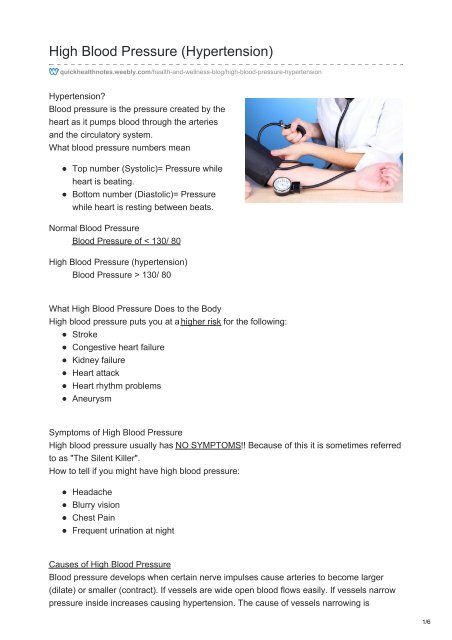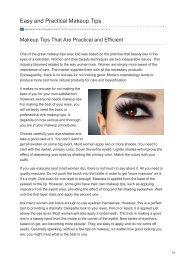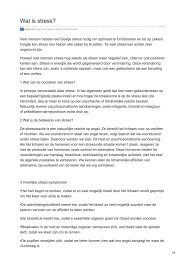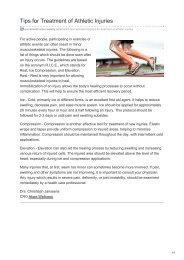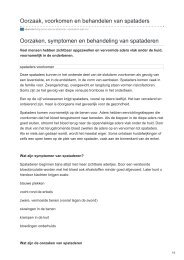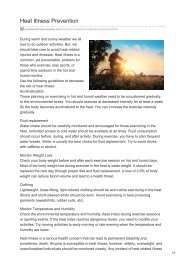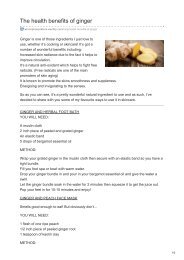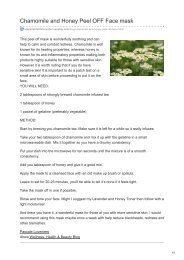High Blood Pressure Hypertension
Create successful ePaper yourself
Turn your PDF publications into a flip-book with our unique Google optimized e-Paper software.
<strong>High</strong> <strong>Blood</strong> <strong>Pressure</strong> (<strong>Hypertension</strong>)<br />
quickhealthnotes.weebly.com/health-and-wellness-blog/high-blood-pressure-hypertension<br />
<strong>Hypertension</strong>?<br />
<strong>Blood</strong> pressure is the pressure created by the<br />
heart as it pumps blood through the arteries<br />
and the circulatory system.<br />
What blood pressure numbers mean<br />
Top number (Systolic)= <strong>Pressure</strong> while<br />
heart is beating.<br />
Bottom number (Diastolic)= <strong>Pressure</strong><br />
while heart is resting between beats.<br />
Normal <strong>Blood</strong> <strong>Pressure</strong><br />
<strong>Blood</strong> <strong>Pressure</strong> of < 130/ 80<br />
<strong>High</strong> <strong>Blood</strong> <strong>Pressure</strong> (hypertension)<br />
<strong>Blood</strong> <strong>Pressure</strong> > 130/ 80<br />
What <strong>High</strong> <strong>Blood</strong> <strong>Pressure</strong> Does to the Body<br />
<strong>High</strong> blood pressure puts you at a higher risk for the following:<br />
Stroke<br />
Congestive heart failure<br />
Kidney failure<br />
Heart attack<br />
Heart rhythm problems<br />
Aneurysm<br />
Symptoms of <strong>High</strong> <strong>Blood</strong> <strong>Pressure</strong><br />
<strong>High</strong> blood pressure usually has NO SYMPTOMS!! Because of this it is sometimes referred<br />
to as "The Silent Killer".<br />
How to tell if you might have high blood pressure:<br />
Headache<br />
Blurry vision<br />
Chest Pain<br />
Frequent urination at night<br />
Causes of <strong>High</strong> <strong>Blood</strong> <strong>Pressure</strong><br />
<strong>Blood</strong> pressure develops when certain nerve impulses cause arteries to become larger<br />
(dilate) or smaller (contract). If vessels are wide open blood flows easily. If vessels narrow<br />
pressure inside increases causing hypertension. The cause of vessels narrowing is<br />
1/6
unknown in 90 to 95% of cases. This is called Primary <strong>Hypertension</strong>. In 5 to 10% of<br />
cases, the cause of vessel narrowing comes from another condition. This is<br />
called Secondary <strong>Hypertension</strong>. Some common conditions that can cause secondary<br />
hypertension are:<br />
Kidney Abnormalities<br />
Narrowing of certain arteries<br />
Rare tumors<br />
Adrenal gland abnormalities<br />
Pregnancy<br />
Risk Factors of <strong>High</strong> <strong>Blood</strong> <strong>Pressure</strong><br />
Risk Factors You Can't Control<br />
Uncontrollable risk factors are inherent to you and cannot be changed. They include:<br />
Heredity<br />
Age<br />
Men between age 35 and 50<br />
Women after menopause<br />
Risk Factors You Can Control<br />
Controllable risk factors are lifestyle choices that increase the risk of high blood pressure.<br />
They include:<br />
Increased salt intake<br />
Obesity<br />
Alcohol consumption<br />
Stress<br />
Lack of exercise<br />
Women and <strong>High</strong> Bood <strong>Pressure</strong><br />
Women are particularly at risk for hypertension due to the following:<br />
Birth Control Pill<br />
Pregnancy<br />
Overweight<br />
After Menopause<br />
What You Can Do to Reduce the Risk of <strong>Hypertension</strong><br />
<strong>High</strong> blood pressure is a lifelong disease. It can be controlled, but not cured. Controlling<br />
blood pressure will reduce the risk of stroke, heart attack, heart failure and kidney disease.<br />
The following lifestyle changes will help you reduce your risk:<br />
Lose weight if your overweight<br />
Get regular physical activity<br />
Avoid excessive alcohol<br />
Stop smoking<br />
Manage your stress<br />
Decrease salt intake<br />
Eat for heart health<br />
2/6
Discuss the use of oral contraceptives with your doctor<br />
Discuss the use of some medications with your doctor<br />
Follow the Ten Commandments for <strong>Blood</strong> <strong>Pressure</strong> Control<br />
The Ten Commandments for <strong>Blood</strong> <strong>Pressure</strong> Control<br />
Know your blood pressure. Have it checked regularly.<br />
Know what your weight should be. Keep it at that level or below.<br />
Don't use excessive salt in cooking or at meals. Avoid salty foods.<br />
Eat a low-fat diet<br />
According to AHA regulations, don't smoke cigarettes or use tobacco products.<br />
Take your medicine exactly as prescribed. Don't run out of pills even for a single day.<br />
Keep your appointments with the doctor.<br />
Follow your doctors advice about exercise.<br />
Make certain family members have their blood pressure checked regularly.<br />
Live a normal life in every other way!<br />
Medication for <strong>High</strong> <strong>Blood</strong> <strong>Pressure</strong><br />
Diuretics - Rid the body of excess fluids and salt.<br />
Beta-blockers - Reduce the heart rate and the work of the heart.<br />
Calcium antagonists - Reduce heart rate and relax blood vessels.<br />
Angiotensin II receptor blockers (ACE) - Interfere with the bodies production of<br />
angiotensin, a chemical that causes the arteries to constrict (narrow).<br />
Vasodialators - Cause the muscle in the wall of the blood vessels to relax, allowing<br />
the vessel to dialate (widen).<br />
Sympathetic nerve inhibitors - Sympathetic nerves go from the brain to all parts of the<br />
body, including the arteries. They cause arteries to constrict raising blood pressure.<br />
These drugs reduce blood pressure by inhibiting these nerves from constricting blood<br />
vessels.<br />
<strong>Blood</strong> <strong>Pressure</strong> Measurement<br />
<strong>Blood</strong> pressure is measured using a sphygmomanometer. There are two numbers in a bood<br />
pressure reading.<br />
Systolic pressure= pressure when 1st sound is heard<br />
Diastolic pressure= pressure when last sound is heard<br />
In order to get an accurate measurement, the size of the blood pressure cuff should be<br />
appropriate.<br />
Small - children and small adults<br />
Average<br />
Large - overweight and large adults<br />
American Heart Association Recommended <strong>Blood</strong> <strong>Pressure</strong> Levels<br />
3/6
Copyright Akwa Wellness<br />
Home <strong>Blood</strong> <strong>Pressure</strong> Monitoring<br />
Mercury sphygmomanometer<br />
Standard for BP monitoring<br />
No calibration<br />
May be bulky<br />
Need a second person to use machine<br />
May be difficult for hearing impaired or patients with arthritis<br />
Aneroid equipment<br />
Inexpensive, lightweight and portable<br />
Two person operation/need stethoscope<br />
Delicate mechanism, easily damaged<br />
Needs calibration with mercury sphygmomanometer<br />
Automatic equipment<br />
Contained in one unit<br />
Portable with easy-to-read digital display<br />
Expensive, fragile<br />
Must be calibrated<br />
Requires careful cuff placement<br />
Drs. Christiaan Janssens MBA<br />
CRO Akwa Wellness<br />
Sources and References:<br />
Rowan, Robert; Schrader, Constance, Control <strong>High</strong> <strong>Blood</strong> <strong>Pressure</strong> Without Drugs: A<br />
Complete <strong>Hypertension</strong> Handbook (2001).<br />
4/6
James, Paul A.; Oparil, Suzanne; Carter, Barry L.; Cushman, William C.; Dennison-<br />
Himmelfarb, Cheryl; Handler, Joel; Lackland, Daniel T.; Lefevre, Michael L.; MacKenzie,<br />
Thomas D.; Ogedegbe, Olugbenga; Smith, Sidney C.; Svetkey, Laura P.; Taler, Sandra J.;<br />
Townsend, Raymond R.; Wright, Jackson T.; Narva, Andrew S.; Ortiz, Eduardo (18<br />
December 2013). "2014 Evidence-Based Guideline for the Management of <strong>High</strong> <strong>Blood</strong><br />
<strong>Pressure</strong> in Adults". JAMA. 311 (5): 507–20.<br />
Lackland, DT; Weber, MA (May 2015). "Global burden of cardiovascular disease and<br />
stroke: hypertension at the core". The Canadian journal of cardiology. 31 (5): 569–71.<br />
Mendis, Shanthi; Puska, Pekka; Norrving, Bo (2011). Global atlas on cardiovascular<br />
disease prevention and control (PDF) (1st ed.). Geneva: World Health Organization in<br />
collaboration with the World Heart Federation and the World Stroke Organization. p. 38.<br />
ISBN 9789241564373.<br />
Hernandorena, I; Duron, E; Vidal, JS; Hanon, O (July 2017). "Treatment options and<br />
considerations for hypertensive patients to prevent dementia". Expert Opinion on<br />
Pharmacotherapy (Review). 18 (10): 989–1000.<br />
Poulter, NR; Prabhakaran, D; Caulfield, M (22 August 2015). "<strong>Hypertension</strong>". Lancet. 386<br />
(9995): 801–12. doi:10.1016/s0140-6736(14)61468-9.<br />
Carretero OA, Oparil S; Oparil (January 2000). "Essential hypertension. Part I: definition<br />
and etiology". Circulation. 101 (3): 329–35. doi:10.1161/01.CIR.101.3.329.<br />
"How Is <strong>High</strong> <strong>Blood</strong> <strong>Pressure</strong> Treated?". National Heart, Lung, and <strong>Blood</strong> Institute. 10<br />
September 2015.<br />
Campbell, NR; Lackland, DT; Lisheng, L; Niebylski, ML; Nilsson, PM; Zhang, XH (March<br />
2015). "Using the Global Burden of Disease study to assist development of nation-specific<br />
fact sheets to promote prevention and control of hypertension and reduction in dietary salt:<br />
a resource from the World <strong>Hypertension</strong> League". Journal of clinical hypertension<br />
(Greenwich, Conn.). 17 (3): 165–67.<br />
Naish, Jeannette; Court, Denise Syndercombe (2014). Medical sciences (2 ed.). p. 562.<br />
ISBN 9780702052491.<br />
Lau, DH; Nattel, S; Kalman, JM; Sanders, P (August 2017). "Modifiable Risk Factors and<br />
Atrial Fibrillation". Circulation (Review). 136 (6): 583–96.<br />
James, PA.; Oparil, S.; Carter, BL.; Cushman, WC.; Dennison-Himmelfarb, C.; Handler, J.;<br />
Lackland, DT.; Lefevre, ML.; et al. (Dec 2013). "2014 Evidence-Based Guideline for the<br />
Management of <strong>High</strong> <strong>Blood</strong> <strong>Pressure</strong> in Adults: Report From the Panel Members Appointed<br />
to the Eighth Joint National Committee (JNC 8)". JAMA. 311 (5): 507–20.<br />
Musini, VM; Tejani, AM; Bassett, K; Wright, JM (7 October 2009). "Pharmacotherapy for<br />
hypertension in the elderly". The Cochrane Database of Systematic Reviews (4):<br />
CD000028.<br />
Sundström, Johan; Arima, Hisatomi; Jackson, Rod; Turnbull, Fiona; Rahimi, Kazem;<br />
Chalmers, John; Woodward, Mark; Neal, Bruce (February 2015). "Effects of <strong>Blood</strong><br />
<strong>Pressure</strong> Reduction in Mild <strong>Hypertension</strong>". Annals of Internal Medicine. 162: 184–91.<br />
Xie, X; Atkins, E; Lv, J; Bennett, A; Neal, B; Ninomiya, T; Woodward, M; MacMahon, S;<br />
Turnbull, F; Hillis, GS; Chalmers, J; Mant, J; Salam, A; Rahimi, K; Perkovic, V; Rodgers, A<br />
(30 January 2016). "Effects of intensive blood pressure lowering on cardiovascular and<br />
renal outcomes: updated systematic review and meta-analysis". Lancet. 387 (10017): 435–<br />
43<br />
Diao, D; Wright, JM; Cundiff, DK; Gueyffier, F (Aug 15, 2012). "Pharmacotherapy for mild<br />
5/6
hypertension". The Cochrane Database of Systematic Reviews. 8: CD006742.<br />
Garrison, SR; Kolber, MR; Korownyk, CS; McCracken, RK; Heran, BS; Allan, GM (8 August<br />
2017). "<strong>Blood</strong> pressure targets for hypertension in older adults". The Cochrane Database of<br />
Systematic Reviews.<br />
Websites:<br />
http://newsroom.cumc.columbia.edu/blog/2018/02/14/understanding-the-new-bloodpressure-treatment-guidelines/<br />
https://www.medicalnewstoday.com/articles/159283.php<br />
https://www.health.harvard.edu/topics/blood-pressure<br />
https://www.healthyhorns.utexas.edu/HT/HT_highbloodpressure.html<br />
http://www.acc.org/latest-in-cardiology/articles/2017/11/08/11/47/mon-5pm-bp-guidelineaha-2017<br />
6/6


